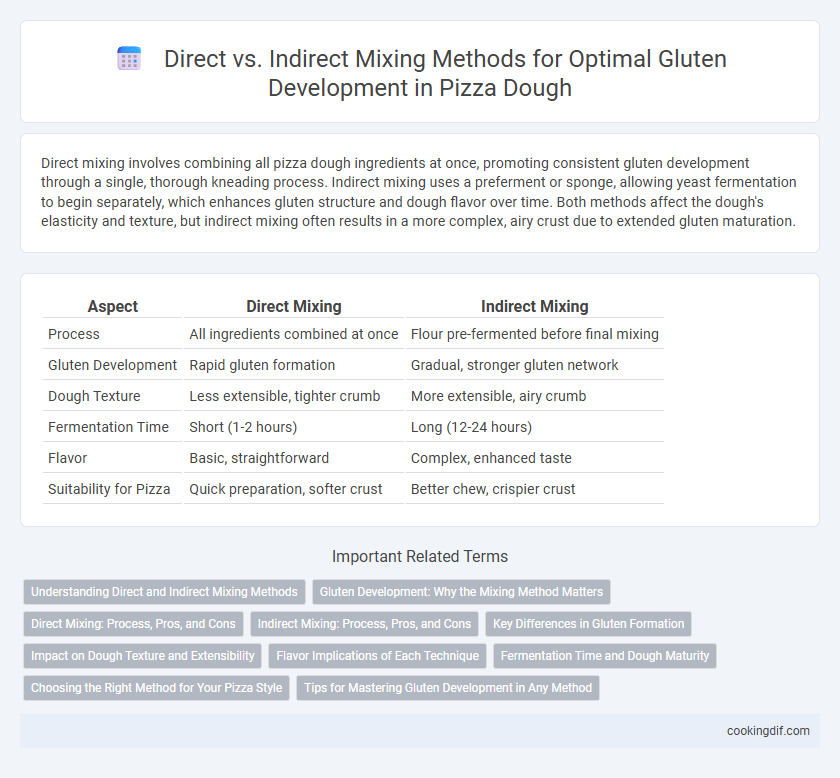Direct mixing involves combining all pizza dough ingredients at once, promoting consistent gluten development through a single, thorough kneading process. Indirect mixing uses a preferment or sponge, allowing yeast fermentation to begin separately, which enhances gluten structure and dough flavor over time. Both methods affect the dough's elasticity and texture, but indirect mixing often results in a more complex, airy crust due to extended gluten maturation.
Table of Comparison
| Aspect | Direct Mixing | Indirect Mixing |
|---|---|---|
| Process | All ingredients combined at once | Flour pre-fermented before final mixing |
| Gluten Development | Rapid gluten formation | Gradual, stronger gluten network |
| Dough Texture | Less extensible, tighter crumb | More extensible, airy crumb |
| Fermentation Time | Short (1-2 hours) | Long (12-24 hours) |
| Flavor | Basic, straightforward | Complex, enhanced taste |
| Suitability for Pizza | Quick preparation, softer crust | Better chew, crispier crust |
Understanding Direct and Indirect Mixing Methods
Direct mixing involves combining all ingredients, including yeast and water, in a single step, promoting faster gluten development and shorter fermentation times suitable for quick pizza dough preparation. Indirect mixing separates the fermentation process by first preparing a pre-ferment or sponge, enhancing flavor complexity and gluten structure through extended fermentation before final mixing. Choosing between direct and indirect mixing methods impacts dough hydration, elasticity, and texture, ultimately influencing the pizza crust's chewiness and rise.
Gluten Development: Why the Mixing Method Matters
Direct mixing involves combining all ingredients simultaneously, allowing immediate gluten network formation that enhances dough strength and elasticity, crucial for pizza crust structure. Indirect mixing separates fermentation steps, promoting enzymatic activity and gluten relaxation, which results in a more extensible dough ideal for thin, crispy pizza bases. The chosen mixing method significantly impacts gluten development, influencing dough texture, rise, and final pizza quality.
Direct Mixing: Process, Pros, and Cons
Direct mixing in pizza dough involves combining all ingredients simultaneously, promoting more consistent gluten development and shorter preparation times. This method benefits pizzerias needing quick turnaround and uniform texture but may sacrifice some flavor complexity compared to indirect mixing. However, direct mixing can lead to less fermentation flavor and potentially tougher crust if not carefully controlled.
Indirect Mixing: Process, Pros, and Cons
Indirect mixing for gluten development in pizza dough involves separating the fermentation and mixing stages, often starting with a pre-ferment like a sponge or poolish. This method enhances gluten strength and dough flavor by allowing enzymes and yeast more time to work, resulting in a more extensible and flavorful crust. However, indirect mixing requires longer preparation time and precise temperature control, which can complicate production but ultimately yields superior texture and taste.
Key Differences in Gluten Formation
Direct mixing involves combining flour, water, yeast, and salt simultaneously, leading to rapid gluten network formation and a more elastic dough texture ideal for traditional pizza crusts. Indirect mixing separates fermentation by first creating a preferment or sponge, which enhances gluten strength and dough extensibility through longer fermentation and enzymatic activity. Key differences in gluten development include faster gluten coherence with direct mixing, while indirect mixing promotes a more complex gluten structure and improved dough flavor.
Impact on Dough Texture and Extensibility
Direct mixing for pizza dough promotes quicker gluten formation resulting in a firm and elastic texture ideal for thin, crispy crusts. Indirect mixing enhances extensibility by allowing a longer fermentation process, which creates a more tender, airy crumb structure common in Neapolitan-style pizzas. Understanding the impact of each method on dough rheology helps optimize texture and stretchability according to desired pizza styles.
Flavor Implications of Each Technique
Direct mixing in pizza dough intensifies gluten development quickly, leading to a chewier, more elastic crust with a straightforward flavor profile. Indirect mixing employs a preferment or sponge, allowing slower gluten formation and fermentation, which enhances complex, tangy, and nuanced flavors in the final pizza. The indirect method's extended fermentation also promotes better dough extensibility, improving mouthfeel without sacrificing structural integrity.
Fermentation Time and Dough Maturity
Direct mixing involves combining all ingredients at once, resulting in a shorter fermentation time but a less developed gluten network, ideal for quick pizza dough preparation. Indirect mixing uses pre-ferments or preferments, extending fermentation time which enhances dough maturity, flavor complexity, and gluten strength for superior texture. Longer fermentation in indirect mixing promotes enzyme activity and gluten relaxation, producing a more extensible and airy pizza crust.
Choosing the Right Method for Your Pizza Style
Direct mixing, involving combining all ingredients at once, develops gluten quickly, ideal for thin-crust pizzas requiring a strong, elastic dough for stretch and crispness. Indirect mixing uses a pre-ferment or sponge, enhancing flavor and texture by allowing gradual gluten development, perfect for thicker, artisanal styles with chewy crumb. Selecting the appropriate method depends on desired crust characteristics, fermentation time, and dough handling preferences specific to your pizza recipe.
Tips for Mastering Gluten Development in Any Method
Direct mixing involves combining all ingredients simultaneously, promoting rapid gluten development ideal for quick doughs, while indirect mixing uses pre-fermented doughs or preferments to enhance flavor and gluten structure over time. For mastering gluten development, maintain precise hydration levels and control mixing time to avoid over or under development regardless of method. Incorporate rest periods during mixing to allow gluten strands to align, improving dough elasticity and texture for optimal pizza crust.
Direct vs Indirect mixing for gluten development Infographic

 cookingdif.com
cookingdif.com